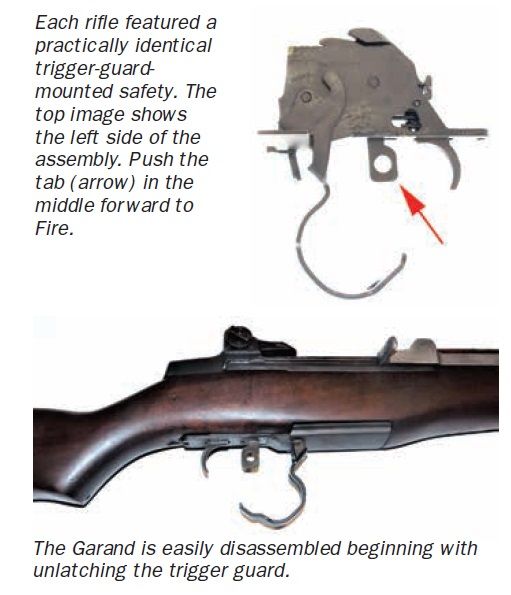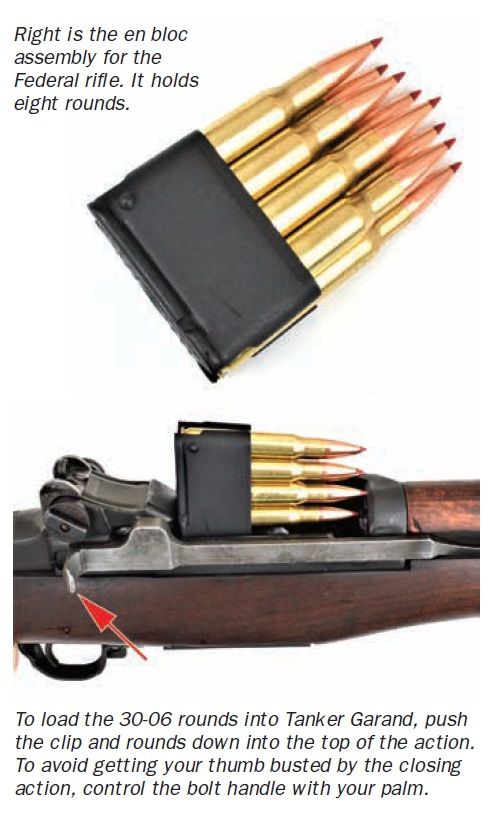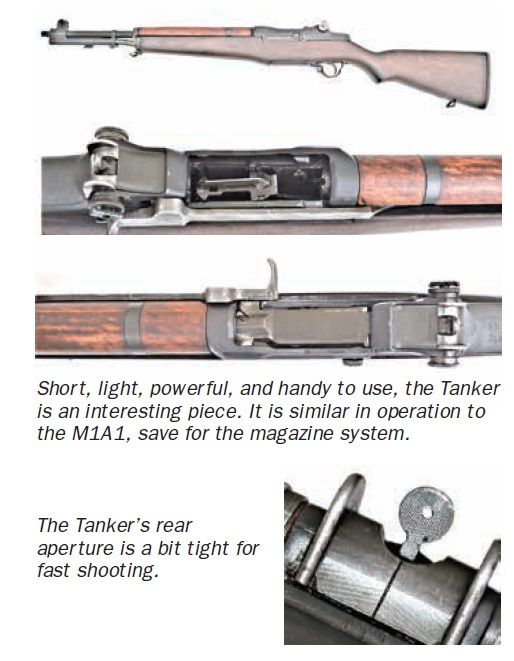GUN TESTS GRADE: B
$775 (used)
It is difficult to qualify the value and selling price of the Tanker Garand because so few come up for sale. The version listed was purchased at a fair price, we feel, and seemed well put together. The term Tanker Garand is an odd one in some ways because the original experimental Garand these pieces are modeled after were not intended for use in tanks. Jungle Garand might be a better title. They were a short-barrel version of the Garand intended to be useful in the Pacific at close quarters and for paratroopers. A few original rifles were modified and not adopted for manufacture. They may have been unsuitable for warfare or they may have been discontinued simply because the war was over before they were properly tested. In any case, the survivors are in a museum. Original Garand rifles were chambered for the 30-06 Springfield cartridge. Later rifles and some Tanker Garands were chambered for the 308 Winchester. Ours is one of the former versions chambered for the 30-06. All modern Tanker Garands are custom or small-shop production. The rifle features a barrel shortened to 18 inches. The result is a lighter rifle at 8.0 pounds, versus 9.5 pounds for the full-size version. Other than that, the rifle operates and fires in the same manner as the M1 Garand rifle. The Garand is gas operated, and the resemblance to the M1A is obvious. The greatest difference is that the Garand uses an en bloc clip, a sheet-metal assembly loaded with eight cartridges. To load the rifle, the shooter locks the bolt to the rear. Push the loaded clip into the Garand’s internal magazine. As the clip is loaded, the follower is pressed down and the clip locks in place. The thumb has pressed the clip into place. The outside of the hand then moves the operating handle slightly to the rear and quickly moves away, releasing the bolt to fly forward and load the rifle. The safety is in the same location as the M1A previously discussed. The rifle is fired, and after the eighth round, the bolt locks to the rear and the en block clip is ejected with a distinctive ping. The Tanker Garand features good wood-to-metal fit. The finish on the parts and final fitting seemed good. The trigger is lighter than either of the Springfield rifles, but then the parts have been around a long time. The last military Garand was manufactured in 1957, to the best of our knowledge. The rifle seemed to be well put together and did not look like a parts gun, which of course it is.
All modern Tanker Garands are custom or small-shop production. The rifle features a barrel shortened to 18 inches. The result is a lighter rifle at 8.0 pounds, versus 9.5 pounds for the full-size version. Other than that, the rifle operates and fires in the same manner as the M1 Garand rifle. The Garand is gas operated, and the resemblance to the M1A is obvious. The greatest difference is that the Garand uses an en bloc clip, a sheet-metal assembly loaded with eight cartridges. To load the rifle, the shooter locks the bolt to the rear. Push the loaded clip into the Garand’s internal magazine. As the clip is loaded, the follower is pressed down and the clip locks in place. The thumb has pressed the clip into place. The outside of the hand then moves the operating handle slightly to the rear and quickly moves away, releasing the bolt to fly forward and load the rifle. The safety is in the same location as the M1A previously discussed. The rifle is fired, and after the eighth round, the bolt locks to the rear and the en block clip is ejected with a distinctive ping. The Tanker Garand features good wood-to-metal fit. The finish on the parts and final fitting seemed good. The trigger is lighter than either of the Springfield rifles, but then the parts have been around a long time. The last military Garand was manufactured in 1957, to the best of our knowledge. The rifle seemed to be well put together and did not look like a parts gun, which of course it is.
| Action | Gas-operated semi-automatic |
| Overall Length | 37.5 in. |
| Overall Height | 4.75 in. |
| Maximum Width | 4.75 in. |
| Weight Unloaded | 8.0 lbs. |
| Capacity | 8 |
| Barrel | 18.0 in. |
| Trigger Style | Two-stage military |
| Trigger Weight | 6.75 lbs. |
| Buttstock | Wood |
| Fore-end | Wood |
| Magazine | En bloc clip |
| Magazine Release | Manual |
| Bolt Release | Manual |
| Rear Sight | Aperture |
| Front Sight | Blade |
| Receiver Scope Provisions | None |
| Warranty | None |
| Telephone | NA |
| Website | NA |
| Made In | USA |
 In firing, we loaded the rifle and worked over targets on the same course as the M1A. There was greater recoil, not by a great margin, but noticeable compared to the M1A. The Garand has a shorter length of pull and it doesn’t have a recoil pad. The Garand simply pushes a bit more horsepower. In firing, control was excellent for those using proper technique. After a bit of acclimation, our shooters made both rapid hits and rapid reloads. The drill to reload is different, of course. The shooter takes the rifle down from the shoulder to push in the en bloc clip loaded with cartridges. The M1A may be reloaded from the shoulder if you have long arms and practice. Eight rapid, accurately delivered 30-06 cartridges will be up to the task of stopping most threats, man or beast. With practice, the reload is fast and sure, but for those who do not master the drill, getting an M1 thumb — the powerful bolt pushing the thumb into the chamber — is more than possible and not very pleasant. Fast hits were possible and comparable to the M1A. Firing at man-sized targets and steel plates, the results were good to 100 yards. The Garand handles well, and it is perhaps underrated for close-quarters combat. We ran across one shortcoming, simply a consideration, and one which the owner will address at a later date. The rear aperture is the proper sight for a standard Garand. When the barrel is shortened, the front post assembly is moved closer to the rear peep sight. To our eyes, the sight picture was a bit too tight. A gunsmith will have to remove the rear sight and very slightly drill it out.
In firing, we loaded the rifle and worked over targets on the same course as the M1A. There was greater recoil, not by a great margin, but noticeable compared to the M1A. The Garand has a shorter length of pull and it doesn’t have a recoil pad. The Garand simply pushes a bit more horsepower. In firing, control was excellent for those using proper technique. After a bit of acclimation, our shooters made both rapid hits and rapid reloads. The drill to reload is different, of course. The shooter takes the rifle down from the shoulder to push in the en bloc clip loaded with cartridges. The M1A may be reloaded from the shoulder if you have long arms and practice. Eight rapid, accurately delivered 30-06 cartridges will be up to the task of stopping most threats, man or beast. With practice, the reload is fast and sure, but for those who do not master the drill, getting an M1 thumb — the powerful bolt pushing the thumb into the chamber — is more than possible and not very pleasant. Fast hits were possible and comparable to the M1A. Firing at man-sized targets and steel plates, the results were good to 100 yards. The Garand handles well, and it is perhaps underrated for close-quarters combat. We ran across one shortcoming, simply a consideration, and one which the owner will address at a later date. The rear aperture is the proper sight for a standard Garand. When the barrel is shortened, the front post assembly is moved closer to the rear peep sight. To our eyes, the sight picture was a bit too tight. A gunsmith will have to remove the rear sight and very slightly drill it out. This sight may have been an impediment in fast reactive shooting, but just the same, the Tanker Garand handled very quickly. The natural balance was excellent. One of the raters said that while recoil was greater, the Tanker Garand and the SOCOM rifle gave up little in rapid handling to the M1 30 Carbine. We did not all agree with that comparison, but the Tanker Garand is a fast-handling rifle. In firing off the benchrest, the Tanker Garand’s small aperture was perhaps more of an asset than an impediment, although time between aiming each shot was greater. The rifle turned in credible groups. The Fiocchi loading averaged just over 2 inches. The rifle did not like the heavy 180-grain JSP as much, with a 2.5-inch 100-yard group. The Hornady Garand load gave excellent accuracy, with a group of 1.75 inches for five shots. Our Team Said: As it turned out, the Tanker Garand is a good shooter, fast shooting, and reliable. The two Springfields outclass this 30-06, but if you can find this Federal Ordnance M1 Garand as a used product in good shape, it will often be available at a several-hundred-dollar discount under the others. That alone might make it Your Pick. Written and photographed by Gun Tests Staff, using evaluations from Gun Tests team testers.
This sight may have been an impediment in fast reactive shooting, but just the same, the Tanker Garand handled very quickly. The natural balance was excellent. One of the raters said that while recoil was greater, the Tanker Garand and the SOCOM rifle gave up little in rapid handling to the M1 30 Carbine. We did not all agree with that comparison, but the Tanker Garand is a fast-handling rifle. In firing off the benchrest, the Tanker Garand’s small aperture was perhaps more of an asset than an impediment, although time between aiming each shot was greater. The rifle turned in credible groups. The Fiocchi loading averaged just over 2 inches. The rifle did not like the heavy 180-grain JSP as much, with a 2.5-inch 100-yard group. The Hornady Garand load gave excellent accuracy, with a group of 1.75 inches for five shots. Our Team Said: As it turned out, the Tanker Garand is a good shooter, fast shooting, and reliable. The two Springfields outclass this 30-06, but if you can find this Federal Ordnance M1 Garand as a used product in good shape, it will often be available at a several-hundred-dollar discount under the others. That alone might make it Your Pick. Written and photographed by Gun Tests Staff, using evaluations from Gun Tests team testers.





























Thanks for your thorough review of the Tanker. My great nephew joined the Army this spring and is now stationed at Ft. Hood. He is a 27 year old late bloomer but has distinguished himself by being selected for 1st Cavalry. He has been on maneuvers and is being trained as a loader for the M1 Abrams. He appreciates history and firearms so we are looking for a Tanker Garand for his collection.
I saw one some years ago at a gun store in Jacksonville NC and that is the only one I have seen.
Thanks again for your review, very informative.